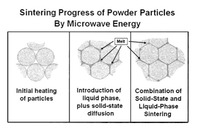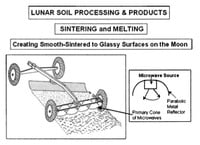 We just finished reading a paper describing the viability of using microwaves to fuse lunar soil (regoilith) into solid shapes, in the hopes of creating an effective way of building lunar structures for future astronauts and their bases.
We just finished reading a paper describing the viability of using microwaves to fuse lunar soil (regoilith) into solid shapes, in the hopes of creating an effective way of building lunar structures for future astronauts and their bases. The chemistry and process are fascinating. It seems that most of the lunar regolith was formed by countless micrometeorite strikes over the eons, resulting in the fine, powdery surface soil we see today. But there’s another interesting aspect: during the micrometeorite strike, there is an amount of heating that vaporizes material. This evaporate rapidly condenses on nearby particles, coating them with a “rim” of new material. This means that most of the regolith is coated with np-Fe0, which turns out to be an excellent material for heating by microwave radiation.
So let’s recap here: ubiquitous uniformly-powdery lunar soil can be very efficiently fused using microwaves. That sounds very similar to technologies used in 3D printing, doesn’t it?
 Lawrence A. Taylor and Thomas T. Meek, the authors of the article (which appeared in the Journal of Aerospace Engineering in 2005) suggest using a solar powered wagon (above), which could be dragged over a levelled section of lunar regolith to fuse it into a solid platform. They also suggest a brick-making capability.
Lawrence A. Taylor and Thomas T. Meek, the authors of the article (which appeared in the Journal of Aerospace Engineering in 2005) suggest using a solar powered wagon (above), which could be dragged over a levelled section of lunar regolith to fuse it into a solid platform. They also suggest a brick-making capability. We suggest a more dramatic possibility: using 3D printing technology on the moon. One can imagine a solar powered unit that does the following:
- Accepts raw, shovelled regolith
- Sorts and stores regolith of the appropriate particle size
- Feeds standard-sized regolith particles into a spreader
- Spreads a uniform layer of powder
- Moves a microwaving print head across the powder layer, fusing appropriate portions
- Raises the print head and repeat another layer
These issues are routinely handled by several types of 3D print technology today, and we suspect making this technology would not be as difficult as inventing something new. Once implemented, we’d have a machine that could build any manner of structures or structural components from a nearly infinite amount of raw lunar material.
We have the technology.
Via ISRUInfo (PDF)


Thanks, fixed it up!
Thanks, fixed it up!
Your ISRUinfo link is incorrect. The correct one is http://www.isruinfo.com/docs/microwave_sintering_of_lunar_soil.pdf
The potential for large-scale automated production of basic construction material is fascinating.
Your ISRUinfo link is incorrect. The correct one is http://www.isruinfo.com/docs/microwave_sintering_of_lunar_soil.pdf
The potential for large-scale automated production of basic construction material is fascinating.